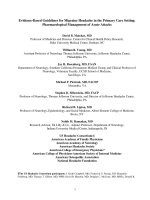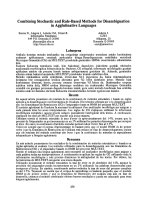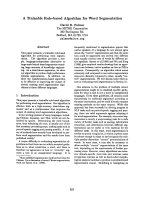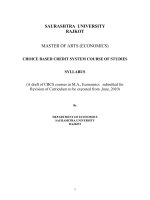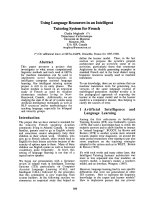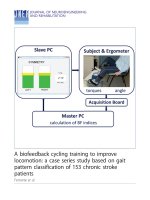Advances in fuzzy rule based system for pattern classification
Bạn đang xem bản rút gọn của tài liệu. Xem và tải ngay bản đầy đủ của tài liệu tại đây (3.49 MB, 223 trang )
ADVANCES IN FUZZY RULE-BASED
SYSTEM FOR PATTERN CLASSIFICATION
CHUA TECK WEE
(B.Eng.(Hons.),UTM)
A THESIS SUBMITTED
FOR THE DEGREE OF DOCTOR OF PHILOSOPHY
DEPARTMENT OF ELECTRICAL AND COMPUTER
ENGINEERING
NATIONAL UNIVERSITY OF SINGAPORE
2010
i
Acknowledgments
I am grateful to many people for supporting me not only intellectually, but also
furnishing me with joy and inspiration in other aspects of life outside of work. This
acknowledgement can only give a glimpse on how much I benefited and learnt from
all my mentors, colleagues, friends, and family. Thank you so much to all of you.
First of all, I wish to sincerely thank my supervisor Assoc. Prof. Tan Woei
Wan, who supplied me with invaluable advice and guidance throughout my time at
the university concerning my research, writing, organisation, and life. Her insights
in fuzzy logic are always stimulating and many chapters of this thesis were shaped
by the numerous discussions we had in the weekly meetings since year 2005.
I am also thankful to Assoc. Prof. Tan Kay Chen and Assoc. Prof. Dipti
Srinivasan for building up my fundamentals in Neural Networks and Evolutionary
Computation. I would also like to express my gratitude to my colleagues for their
inspirational input and my friends for their true friendship. Finally, I am forever
grateful to my loving family back in Malaysia. This thesis would not have been
possible without their encouragement and love.
ii
Contents
Acknowledgments i
Summary vii
List of Figures x
List of Tables xviii
Chapter 1 Introduction 1
1.1 Fundamental Concepts of Pattern Classification . . . . . . . . . . . 2
1.2 Fundamental Concepts of Fuzzy Logic System . . . . . . . . . . . . 4
1.2.1 Type-1 Fuzzy Logic System . . . . . . . . . . . . . . . . . . 6
1.2.2 Type-2 Fuzzy Logic System . . . . . . . . . . . . . . . . . . 7
1.3 Overview of Fuzzy Pattern Classification . . . . . . . . . . . . . . . 11
1.3.1 Why should we use fuzzy classifier? . . . . . . . . . . . . . . 12
1.3.2 Types of fuzzy classifiers . . . . . . . . . . . . . . . . . . . . 13
1.3.2.1 Fuzzy rule-based classifier . . . . . . . . . . . . . . 14
1.3.2.2 Non fuzzy rule-based classifier . . . . . . . . . . . . 18
1.4 Literature Review on Fuzzy Pattern Classification . . . . . . . . . . 21
1.4.1 Non-singleton fuzzy classifiers . . . . . . . . . . . . . . . . . 22
iii
1.4.2 Type-2 fuzzy classifiers . . . . . . . . . . . . . . . . . . . . . 23
1.4.3 Learning of fuzzy classifiers . . . . . . . . . . . . . . . . . . 25
1.5 Aims and Scope of the Work . . . . . . . . . . . . . . . . . . . . . . 28
1.6 Organisation of the Thesis . . . . . . . . . . . . . . . . . . . . . . . 31
Chapter 2 Non-Singleton Fuzzy Rule-Based Classifier: Handling
the Input Uncertainty 33
2.1 Non-Singleton Fuzzy Rule-Based Classifier (NSFRBC) . . . . . . . 35
2.2 Characteristics of Non-Singleton Fuzzy Rule-Based Classifier . . . . 38
2.3 Application to ECG Arrhythmias Classification . . . . . . . . . . . 41
2.3.1 Background Information . . . . . . . . . . . . . . . . . . . . 41
2.3.2 Feature Extraction . . . . . . . . . . . . . . . . . . . . . . . 43
2.3.3 Structure of the Fuzzy Classifiers . . . . . . . . . . . . . . . 47
2.3.4 Classifier Training . . . . . . . . . . . . . . . . . . . . . . . 48
2.3.5 Results and Discussion . . . . . . . . . . . . . . . . . . . . . 51
2.4 Conclusion . . . . . . . . . . . . . . . . . . . . . . . . . . . . . . . . 58
Chapter 3 Type-2 Fuzzy Rule-Based Classifiers 59
3.1 Interval Type-2 Fuzzy Rule-Based Classifier . . . . . . . . . . . . . 60
3.2 Type-2 Fuzzy Rule-Based Classifier Design Methods . . . . . . . . . 67
3.3 Experimental Results . . . . . . . . . . . . . . . . . . . . . . . . . . 70
3.4 Conclusion . . . . . . . . . . . . . . . . . . . . . . . . . . . . . . . . 78
Chapter 4 Robustness Analysis of Type-1 and Type-2 Fuzzy Rule-
Based Classifiers 79
iv
4.1 Introduction . . . . . . . . . . . . . . . . . . . . . . . . . . . . . . . 80
4.2 Robustness of Type-2 Fuzzy Classifier . . . . . . . . . . . . . . . . . 83
4.2.1 Robustness Towards Noisy Unseen Samples . . . . . . . . . 85
4.2.2 Robustness Against Selected Features . . . . . . . . . . . . . 88
4.2.3 Robustness To Randomness in Design Methods . . . . . . . 97
4.3 Conclusion . . . . . . . . . . . . . . . . . . . . . . . . . . . . . . . . 99
Chapter 5 Towards An Efficient Fuzzy Rule-Based Classifier Learn-
ing Algorithm with Support Vector Machine 102
5.1 Introduction . . . . . . . . . . . . . . . . . . . . . . . . . . . . . . . 102
5.2 Architecture of EFSVM-FCM . . . . . . . . . . . . . . . . . . . . . 105
5.3 Training of EFSVM-FCM . . . . . . . . . . . . . . . . . . . . . . . 108
5.3.1 Antecedent Part Learning . . . . . . . . . . . . . . . . . . . 110
5.3.2 Consequent Part Learning . . . . . . . . . . . . . . . . . . . 111
5.4 Performance Evaluation . . . . . . . . . . . . . . . . . . . . . . . . 114
5.5 Conclusion . . . . . . . . . . . . . . . . . . . . . . . . . . . . . . . . 117
Chapter 6 On Improving K-Nearest Neighbor Classifier with Fuzzy
Rule-Based Initialisation 120
6.1 Introduction . . . . . . . . . . . . . . . . . . . . . . . . . . . . . . . 121
6.2 The Crisp and Fuzzy K-NN Algorithms . . . . . . . . . . . . . . . . 124
6.2.1 The Conventional Crisp K-NN Algorithm . . . . . . . . . . . 124
6.2.2 Fuzzy K-NN Algorithm . . . . . . . . . . . . . . . . . . . . . 126
6.3 Fuzzy Rule-Based K-NN . . . . . . . . . . . . . . . . . . . . . . . . 127
6.3.1 Weighted Euclidean Distance Measure . . . . . . . . . . . . 133
v
6.4 Genetic Learning of Fuzzy Rule-Based K-NN . . . . . . . . . . . . . 134
6.5 Computational Experiments . . . . . . . . . . . . . . . . . . . . . . 136
6.5.1 Minimising the Effect of Insufficient Training Data . . . . . 137
6.5.2 Handling the Issue of Noise Uncertainty . . . . . . . . . . . 140
6.6 Conclusion . . . . . . . . . . . . . . . . . . . . . . . . . . . . . . . . 144
Chapter 7 Practical Application of Fuzzy Rule-Based Classifier for
Inverter-Fed Induction Motor Fault Diagnosis 146
7.1 Introduction . . . . . . . . . . . . . . . . . . . . . . . . . . . . . . . 146
7.2 Motor Current Spectral Analysis . . . . . . . . . . . . . . . . . . . 152
7.2.1 Broken Rotor Bar Fault . . . . . . . . . . . . . . . . . . . . 153
7.2.2 Bearing Fault . . . . . . . . . . . . . . . . . . . . . . . . . . 154
7.3 Independent Component Analysis . . . . . . . . . . . . . . . . . . . 156
7.4 Ensemble and Individual Noise Reduction . . . . . . . . . . . . . . 158
7.5 Proposed Algorithm . . . . . . . . . . . . . . . . . . . . . . . . . . 161
7.5.1 Data Requirement and Processing . . . . . . . . . . . . . . . 162
7.5.2 Commissioning Phase . . . . . . . . . . . . . . . . . . . . . . 163
7.5.2.1 Time Domain . . . . . . . . . . . . . . . . . . . . . 163
7.5.2.2 Frequency Domain . . . . . . . . . . . . . . . . . . 164
7.5.2.3 Fuzzy Rule Base . . . . . . . . . . . . . . . . . . . 165
7.5.3 On-line Monitoring Phase . . . . . . . . . . . . . . . . . . . 166
7.6 Experimental Results and Discussion . . . . . . . . . . . . . . . . . 167
7.7 Conclusion . . . . . . . . . . . . . . . . . . . . . . . . . . . . . . . . 172
Chapter 8 Conclusion 174
vi
Author’s Publications 181
Bibliography 184
Appendix 202
vii
Summary
Pattern classification encompasses a wide range of information processing prob-
lems that are of great practical significance, from the classification of handwritten
characters, to fault detection in machinery and medical diagnosis. Fuzzy logic sys-
tem was initially introduced to solve a pattern classification problem because the
system has similar reasoning style to human being. One of the main advantages of
fuzzy logic is that it enables qualitative domain knowledge about a classification
task to be deployed in the algorithmic structure. Despite the popularity of fuzzy
logic system in pattern classification, a conventional singleton type-1 fuzzy logic
system does not capture uncertainty in all of its manifestations, particularly when
it arises from the noisy input and the vagueness in the shape of the membership
function. The aim of this study is to seek a better understanding of the prop-
erties of extensional fuzzy rule-based classifiers (FRBCs), namely non-singleton
FRBC and interval type-2 FRBC. Besides, this research aimed at systemising the
learning procedure for fuzzy rule-based classifier.
Non-singleton FRBC was found to have noise suppression capability. There-
fore, it can better cope with input that is corrupted with noise. In addition,
viii
the analysis demonstrated that non-singleton FRBC is capable of producing vari-
able boundary which may be useful to resolve the overlapping boundary between
classes. The significance is that non-singleton FRBC may reduce the complex-
ity of feature extraction by extending the possibility to use the features that are
easier to extract but contain more uncertainties. As an extension to type-1 fuzzy
classifier, type-2 classifier appears to have better performance and robustness due
to its richness of footprint of uncertainty (FOU) in membership function. The
proposed FOU design methodology can be useful when one is uncertain about
the descriptions for the features (i.e., the membership function). The robustness
study and extensive experimental results suggest that the performance of type-2
FRBC is at least comparable, if not better than type-1 counterpart.
Designing and optimising FRBCs are just as important as understanding the
properties of different types of fuzzy classifiers. In view of this, an efficient learning
algorithm based on support vector machine and fuzzy c-means algorithm was
proposed. Not only that the resulting fuzzy classifier has a compact rule base,
but it also has good generalisation capability. Besides, the curse of dimensionality
which is often faced by FRBCs can be avoided. In the later part of this thesis,
it was also shown that the proposed fuzzy rule-based initialisation procedure can
enhance the performance of conventional crisp and fuzzy K-Nearest Neighbor (K-
NN) when the training data is limited. Moreover, the successful implementation
of the FRBC to classify faults in induction motor has provided clear evidence of
its practical applicability.
In conclusion, it is foreseeable that FRBCs will continue to play an impor-
tant role in pattern classification. With the advances in extensional FRBCs, the
ix
uncertainties which the conventional classifiers failed to address for, can now be
handled more effectively.
x
List of Figures
1.1 (a) The components of a typical classifier and (b) the classifier de-
sign flow. . . . . . . . . . . . . . . . . . . . . . . . . . . . . . . . . 5
1.2 Type-1 fuzzy logic system (FLS). . . . . . . . . . . . . . . . . . . . 6
1.3 Example of a type-2 membership function. J
x
, the primary mem-
bership of x, is the domain of secondary membership function. . . . 8
1.4 FOU (shaded), LMF (dashed), UMF (solid) and an embedded FS
(wavy line) for IT2 FS
A. . . . . . . . . . . . . . . . . . . . . . . . 8
1.5 Type-2 fuzzy logic system (FLS). . . . . . . . . . . . . . . . . . . . 9
1.6 (a) Type-1 membership function, (b) type-2 membership function
(the bounded area is not shaded uniformly to reflect that the sec-
ondary membership grades are in [0,1]), and (c) interval type-2
membership function (the bounded area is shaded uniformly to in-
dicate that all the secondary grades are unity). . . . . . . . . . . . . 10
1.7 The structure of a fuzzy rule-based classifier. . . . . . . . . . . . . . 15
1.8 Footprint of uncertainty (shaded area) of an interval type-2 fuzzy
set FCM. . . . . . . . . . . . . . . . . . . . . . . . . . . . . . . . . 24
xi
1.9 Classification area of each fuzzy if-then rule with a different cer-
tainty grade (weight). . . . . . . . . . . . . . . . . . . . . . . . . . . 27
2.1 Input and antecedent operation for different types of inputs. (a)
Singleton and (b) Non-singleton. . . . . . . . . . . . . . . . . . . . . 36
2.2 Comparison of the classification boundaries produced by (a) non-
singleton fuzzy rule-based classifier (NSFRBC) and (b) singleton
fuzzy logic classifier (SFRBC). NSFRBC produces fuzzy decision
boundary while SFRBC produces crisp decision boundary. . . . . . 40
2.3 ECG components: P wave, QRS complex, and T wave. . . . . . . . 41
2.4 ECG signals (excerpts from VFDB) and corresponding binary se-
quences: (a) NSR, record 421 (50-54s), (b) VF, record 424 (1260-
1264s), (c) VF, record 611(1197-1201s). . . . . . . . . . . . . . . . . 45
2.5 The scatter plots for inputs. (a) Pulse period vs. width, (b) Pulse
amplitude vs. width. . . . . . . . . . . . . . . . . . . . . . . . . . . 46
2.6 Chromosome structure. . . . . . . . . . . . . . . . . . . . . . . . . . 50
2.7 GA convergence trace. . . . . . . . . . . . . . . . . . . . . . . . . . 52
2.8 The boxplot for each configuration over 10 runs. . . . . . . . . . . . 54
3.1 Structure of type-2 fuzzy rule-based classifier. . . . . . . . . . . . . 61
3.2 Supremum operation between type-2 antecedent fuzzy set,
A
k
and
singleton input x
k
produces firing strengths [f,
¯
f]. . . . . . . . . . . 61
xii
3.3 The operations between interval type-2 antecedent with different
types of inputs using minimum t-norm. (a) Singleton input; (b)
Non-singleton type-1 input; and (c) Non-singleton interval type-2
input. . . . . . . . . . . . . . . . . . . . . . . . . . . . . . . . . . . 65
3.4 The design strategy of Type-2 FRBCs. . . . . . . . . . . . . . . . . 67
3.5 Interval type-2 Gaussian membership functions with: (a) uncertain
standard deviations, (b) uncertain means, (c) uncertain standard
deviations and means. . . . . . . . . . . . . . . . . . . . . . . . . . 71
3.6 Type-2 fuzzy rule-based classifier chromosome structure. UMF:
upper membership function, LMF: lower membership function. . . . 73
3.7 Boxplot for case study 1 with 10-CV and ten iterations (a) training
accuracy, (b) testing accuracy. . . . . . . . . . . . . . . . . . . . . . 75
3.8 Boxplot for case study 2 with 10-CV and ten iterations (a) training
accuracy, (b) testing accuracy. . . . . . . . . . . . . . . . . . . . . . 76
3.9 Boxplot for case study 3 with 10-CV and ten iterations (a) training
accuracy, (b) testing accuracy. . . . . . . . . . . . . . . . . . . . . . 76
3.10 Boxplot for case study 4 with 10-CV and ten iterations (a) training
accuracy, (b) testing accuracy. . . . . . . . . . . . . . . . . . . . . . 77
3.11 Boxplot for case study 5 with 10-CV and ten iterations (a) training
accuracy, (b) testing accuracy. . . . . . . . . . . . . . . . . . . . . . 77
4.1 Synthetic train data set: (a) Gaussian, (b) Clown. Each set has
1000 samples. . . . . . . . . . . . . . . . . . . . . . . . . . . . . . . 88
xiii
4.2 Synthetic Gaussian test data set with different noise levels: (a)
Level-0 (σ
G
= 0.25), (b) Level-1 (σ
G
= 0.5), (c) Level-2 (σ
G
= 0.7),
(d) Level-3 (σ
G
= 0.9). Each set has 500 samples. . . . . . . . . . . 89
4.3 Synthetic Clown test data set with different noise levels: (a) Level-
0 (σ
C
= 0.25), (b) Level-1 (σ
C
= 0.5), (c) Level-2 (σ
C
= 0.7), (d)
Level-3 (σ
C
= 0.9). Each set has 500 samples. . . . . . . . . . . . . 90
4.4 Improvement of testing accuracy of type-2 FRBCs over typ e-1 FR-
BCs for data set: (a) Gaussian, (b) Clown. . . . . . . . . . . . . . . 90
4.5 (a) The vibration signals from two cases, there is no clear feature
that distinguishes between both signals by visual inspection. (b)
The average periodogram of the training samples, the more dis-
criminative features are concentrated at the lower frequencies. . . . 92
4.6 2-D scatter plots of PCA projected (a) train data, (b) test data.
Test data has higher degree of overlapping between both classes
due to the noises inherent in the raw data. . . . . . . . . . . . . . . 94
4.7 2-D scatter plots of LDA projected (a) train data, (b) test data. . . 95
4.8 Difference in standard deviations (σ
T 1
−σ
T 2
) for (a) synthetic data
sets and (b) Ford data set (with PCA method). Positive value
denotes type-2 FRBC is more consistent than type-1 FRBC while
negative value denotes type-2 FRBC is less consistent than type-1
FRBC. . . . . . . . . . . . . . . . . . . . . . . . . . . . . . . . . . . 99
xiv
4.9 Total computation time required for 1000 training samples based
on fuzzy system with four rules. Due to different computation time
required for KM type-reduction in type-2 FRBC, the values are
shown as the average of 20 generations. . . . . . . . . . . . . . . . . 100
5.1 Architecture of EFSVM-FCM. . . . . . . . . . . . . . . . . . . . . . 106
5.2 Data distribution for training and testing phases. . . . . . . . . . . 108
5.3 The learning of antecedent part with Genetic Algorithm (GA) and
Fuzzy C-Means (FCM) algorithm, and consequent part with Sup-
port Vector Machine (SVM). . . . . . . . . . . . . . . . . . . . . . . 109
5.4 Boxplot for testing accuracies of four classification tasks with 10
iterations for each task. Two-fold cross validation method is used. . 117
6.1 Interval type-1 fuzzy set. . . . . . . . . . . . . . . . . . . . . . . . . 129
6.2 Decision area computed with different classifiers (a) K = 1, (b) –
(d) K = 3 for crisp K-NN, fuzzy K-NN, and fuzzy rule-based K-
NN respectively. To illustrate the effectiveness of fuzzy rule-based
initialisation procedure only, weighted Euclidean distance measure-
ment is not used. It is clear that the decision area produced by
fuzzy rule-based K-NN resembles the one with K = 1 with minimal
uncertainty. . . . . . . . . . . . . . . . . . . . . . . . . . . . . . . . 132
6.3 When the Euclidean distance measure is unweighted, the query
point is assigned to the same class as data 2 as b oth of them are
closer to each other. . . . . . . . . . . . . . . . . . . . . . . . . . . . 134
xv
6.4 The structure of the chromosome. First part encodes the param-
eters for the antecedent sets while the middle part encodes the
consequent parameters which describe a set of interval type-1 fuzzy
sets. The last part contains the feature weights used in weighted
Euclidean distance measure. . . . . . . . . . . . . . . . . . . . . . . 136
6.5 Comparison of average testing accuracies with different K-NN al-
gorithms for dataset (a) Bupa liver, (b) Glass, (c) Pima Indians
diabetes, (d) Wisconsin breast cancer and (e) Ford automotive. In
overall, fuzzy rule-based K-NN outperforms other NN variants. . . . 139
6.6 Performance distribution for each algorithm is computed by aver-
aging the robustness ratio over the 5 datasets. The box represents
the lower and upper quartiles of the distribution separated by the
median while the outer vertical lines show the entire range of the
distribution. . . . . . . . . . . . . . . . . . . . . . . . . . . . . . . . 143
7.1 Overview of the proposed hybrid time-frequency domain analysis
algorithm. . . . . . . . . . . . . . . . . . . . . . . . . . . . . . . . . 151
7.2 Scatter plot of the extracted 2-D features for fixed supply-fed motor
(50Hz) using Independent Component Analysis (ICA) method. . . . 152
7.3 Current spectrum of an induction motor with broken rotor bars. . . 154
7.4 Uncertain bearing frequencies components between (a) healthy mo-
tor (b) motor with inner race bearing fault. Due to the noise, the
amplitude difference between two classes are less obvious. . . . . . . 156
xvi
7.5 50Hz Stator current signal from the (a) fixed supply-fed induction
motor (b) inverter-fed induction motor. . . . . . . . . . . . . . . . . 159
7.6 Scatter plot of the extracted 2-D features for inverter-fed motor
(50Hz) using Independent Component Analysis (ICA) method. . . . 160
7.7 Ensemble and individual noise reduction procedures. . . . . . . . . 160
7.8 Scatter plot of the ICA extracted 2-D features for inverter-fed motor
(50Hz) after applying Emsemble and Individual Noise Reduction
technique. . . . . . . . . . . . . . . . . . . . . . . . . . . . . . . . . 161
7.9 Details of the proposed hybrid time-frequency domain analysis al-
gorithm. . . . . . . . . . . . . . . . . . . . . . . . . . . . . . . . . . 163
7.10 Healthy and faulty clusters (bearing and broken rotor bar) for vari-
able inverter frequencies during training stage except the left top
one for fixed supply frequency. Each cluster contains 30 training
data points. . . . . . . . . . . . . . . . . . . . . . . . . . . . . . . . 164
7.11 Fuzzy membership functions for four inputs: (a) distance, d (b) am-
plitude of the left sideband, A
side
, (c) amplitude difference of the
fundamental component and left sideband, A
diff
(d) amplitude of
the bearing fault component, A
brg
. Note that the distance member-
ship function is adaptive with respect to the operating speed, (a)
only shows one of the instances. . . . . . . . . . . . . . . . . . . . . 167
7.12 Experiment setup. . . . . . . . . . . . . . . . . . . . . . . . . . . . 168
7.13 Two holes are drilled on the rotor bar to simulate broken rotor bar. 168
xvii
7.14 The effect of Euclidean distance threshold, τ towards the classi-
fication accuracies for (a) hybrid time-frequency domain analysis
algorithm, (b) independent time domain analysis algorithm. . . . . 172
xviii
List of Tables
2.1 Firing Strengths of The Example in Section 2.1 . . . . . . . . . . . 39
2.2 Upper and lower limits of the parameters . . . . . . . . . . . . . . . 50
2.3 Notation Used In Sensitivity And Specificity Equations . . . . . . . 53
2.4 Classification Results With Different Configurations . . . . . . . . . 55
2.5 Comparative Results of Different Arrhythmia Classification Methods 57
3.1 Comparisons of Type-1 and Type-2 Singleton and Non-Singleton
FLSs. . . . . . . . . . . . . . . . . . . . . . . . . . . . . . . . . . . . 61
3.2 Average Training Accuracies of FRBCs (in %) . . . . . . . . . . . . 75
3.3 Average Testing Accuracies of FRBCs (in %) . . . . . . . . . . . . . 75
4.1 Classification Results for Gaussian Data. The Classifiers are Trained
With Noiseless Data and Tested With Data Under Different Noise
Levels. . . . . . . . . . . . . . . . . . . . . . . . . . . . . . . . . . . 88
4.2 Classification Results for Clown Data. The Classifiers are Trained
With Noiseless Data and Tested With Data Under Different Noise
Levels. . . . . . . . . . . . . . . . . . . . . . . . . . . . . . . . . . . 89
4.3 Confusion Matrix for a Binary Classifier . . . . . . . . . . . . . . . 94
xix
4.4 Average and Standard Deviation of Classification Accuracy and
False Positive Rate Across 10 Iterations with PCA Based Feature
Extraction. . . . . . . . . . . . . . . . . . . . . . . . . . . . . . . . 96
4.5 Average and Standard Deviation of Classification Accuracy and
False Positive Rate Across 10 Iterations with LDA Based Feature
Extraction. . . . . . . . . . . . . . . . . . . . . . . . . . . . . . . . 96
4.6 Testing Accuracies and False Positive Rates Comparisons Between
The Proposed FRBC and Lv Jun’s Classifier . . . . . . . . . . . . . 97
5.1 Summary of Datasets . . . . . . . . . . . . . . . . . . . . . . . . . . 116
5.2 EFSVM-FCM Parameters Used for Classification Tasks . . . . . . . 116
5.3 Classification Results of Iris Data with Various Methods . . . . . . 118
5.4 Classification Results of Wine Data with Various Methods . . . . . 118
5.5 Classification Results of Liver Data with Various Methods . . . . . 118
5.6 Classification Results of Glass Data with Various Methods . . . . . 119
6.1 Summary of Datasets . . . . . . . . . . . . . . . . . . . . . . . . . . 137
6.2 The Classification Accuracy Improvement of Fuzzy K-NN with Weighted
Euclidean Distance (Fuzzy KNN*) and Fuzzy Rule-Based K-NN
(FRB-KNN) Compared to Conventional Fuzzy K-NN on four UCI
Datasets. . . . . . . . . . . . . . . . . . . . . . . . . . . . . . . . . . 140
6.3 Average Testing Accuracies (in %) on Different Datasets with Six
Competing Classifiers. . . . . . . . . . . . . . . . . . . . . . . . . . 142
6.4 Robustness Index for Six Different Classifiers. . . . . . . . . . . . . 143
7.1 Rated Parameters of the Induction Motor Under Study . . . . . . . 168
xx
7.2 Measured Rotor Speeds and Computed Broken Rotor Bar Frequencies169
7.3 Measured Rotor Speeds and Computed Inner Race Bearing Fault
Frequencies . . . . . . . . . . . . . . . . . . . . . . . . . . . . . . . 170
7.4 Bearing Parameters . . . . . . . . . . . . . . . . . . . . . . . . . . . 170
7.5 Proposed Hybrid Algorithm Performance . . . . . . . . . . . . . . . 172
1
Chapter 1
Introduction
Pattern classification problems emerge constantly in everyday life: reading texts,
identifying people, retrieving objects, or finding the way in a city. In order to
perceive and react to different situations, individuals must process the sensory
information received by the eyes, ears, skin etc. This information contains the fea-
tures or attributes of the objects. Humans recognise two objects as being similar
because they have similarly valued common attributes. Often these are problems
which many humans solve in a seemingly effortless fashion. In contrast, their so-
lution using computers has, in many cases, proved to be immensely difficult. In
order to have effective solutions, it is important to adopt a principled approach
based on sound theoretical concepts. Advances in pattern classification is impor-
tant for building intelligent machines that emulate humans. Fuzzy logic system is
one of the popular machine learning techniques that has been successfully applied
to pattern classification.
It is well known that the concept of fuzzy set first originated from the study
of problems related to pattern classification [1]. This is not surprising because
2
the process of recognising a pattern, which is an important aspect of human per-
ception, is a fuzzy process in nature. The fuzziness can include the changes in
object orientation and size, degree of incompleteness and distortion, amount of
background noise, vague descriptions, imprecise measurements, conflicting or am-
biguous information, random occurrences and etc. A large amount of literature
has been published dealing with fuzzy pattern classification, the search results re-
trieved from the search engine upon the keyword “fuzzy classifiers” is astonishing.
Google search engine returned this statistic at 10 p.m. on August 22, 2009:
“Results 1 - 10 of about 524,000 for fuzzy classifiers. (0.37 seconds).”
It seems that applications of fuzzy pattern classification are far ahead of the theory
on the matter. Majority of the works only involved conventional type-1 fuzzy
logic systems or used simple notion of fuzzy sets. The advantages and prop erties
of extensional fuzzy logic systems (FLSs) such as non-singleton FLSs and type-2
FLSs are far from being explored. The chapter will provide a brief introduction
to pattern classification and fuzzy sets and more attention will be given to the
overview of fuzzy pattern classification.
1.1 Fundamental Concepts of Pattern Classifica-
tion
Classification can be divided into supervised and unsupervised classification. In
supervised classification, also termed discrimination, a set of data samples consist-
ing of a set of variables is available. All the samples in the data set are labelled;
they are thus all assigned to a specific class. With unsupervised classification,
3
sometimes termed clustering, the samples in the data set are not labelled.
Class is a core notion in pattern classification. Let Ω be a set of class labels
Ω = {ω
1
, ω
2
, . . . , ω
c
} where ω
i
is the class label. The term class symbolises a group
of objects with a common characteristic or common meaning. Features (variables)
are used to describe the objects numerically. The feature values for a given object
are arranged as an n-dimensional vector x = [x
1
, x
2
, . . . , x
n
]
T
∈
n
. The real
space
n
is called feature space, each axis corresponding to a physical feature. A
classifier is any function:
D :
n
→ Ω (1.1)
The decision functions partition the feature space
n
into c (not necessarily com-
pact) decision regions or classification regions denoted by R
1
, R
2
, . . . , R
c
R
i
=
x|x ∈
n
, g
i
(x) = max
k=1, ,c
g
k
(x)
, i = 1, . . . , c (1.2)
where G = {g
1
(x), g
2
(x), . . . , g
c
(x)} is a set of decision functions in the canonical
model of a classifier. The b oundaries of the decision regions are called classification
boundaries. A point on the boundary can be assigned to any of the bordering
classes. If the classes in data set, Z can be separated completely from each other
by a hyperplane (a point in , a line in
2
, a plane in
3
), they are called linearly
separable [2].
There are two methods to develop classifiers. The first one is parametric
method, in which a priori knowledge of data distributions is assumed. A clas-
sical example of classifier that uses this approach is Bayes classifier. The second
one is nonparametric method, in which no a priori knowledge is assumed. Neural
4
Networks [3], fuzzy systems [4], and Support Vector Machines (SVM) [5] are typi-
cal nonparametric classifiers. The classifier acquires its decision function through
the training using input-output pairs.
The typical components of a classifier and the design flow of a classifier are
shown in Fig. 1.1. The feature extraction step transforms raw data (observation
space) into feature vectors (feature space). The resulting feature space is of a much
lower dimension than the observation space. The next step is a transformation of
the feature space into a decision space, which is defined by a (finite) set of classes.
A classifier, which is an algorithm, generates a partitioning of the feature space
into a number of decision regions. After the classifier is designed and a desired
level of performance is achieved, it can be used to classify new objects. This means
that the classifier assigns every feature vector in the feature space to a class in the
decision space.
1.2 Fundamental Concepts of Fuzzy Logic Sys-
tem
Fuzzy set theory is not a theory that permits vagueness in our computations, but it
is rather a methodology to show how to tackle uncertainty, and to handle imprecise
information in a complex situation. Fuzzy sets are the core element in Fuzzy Logic.
They are characterised by membership functions which are associated with terms
or words used in the antecedent and consequents of rules, and with input and
output to the fuzzy logic system.

